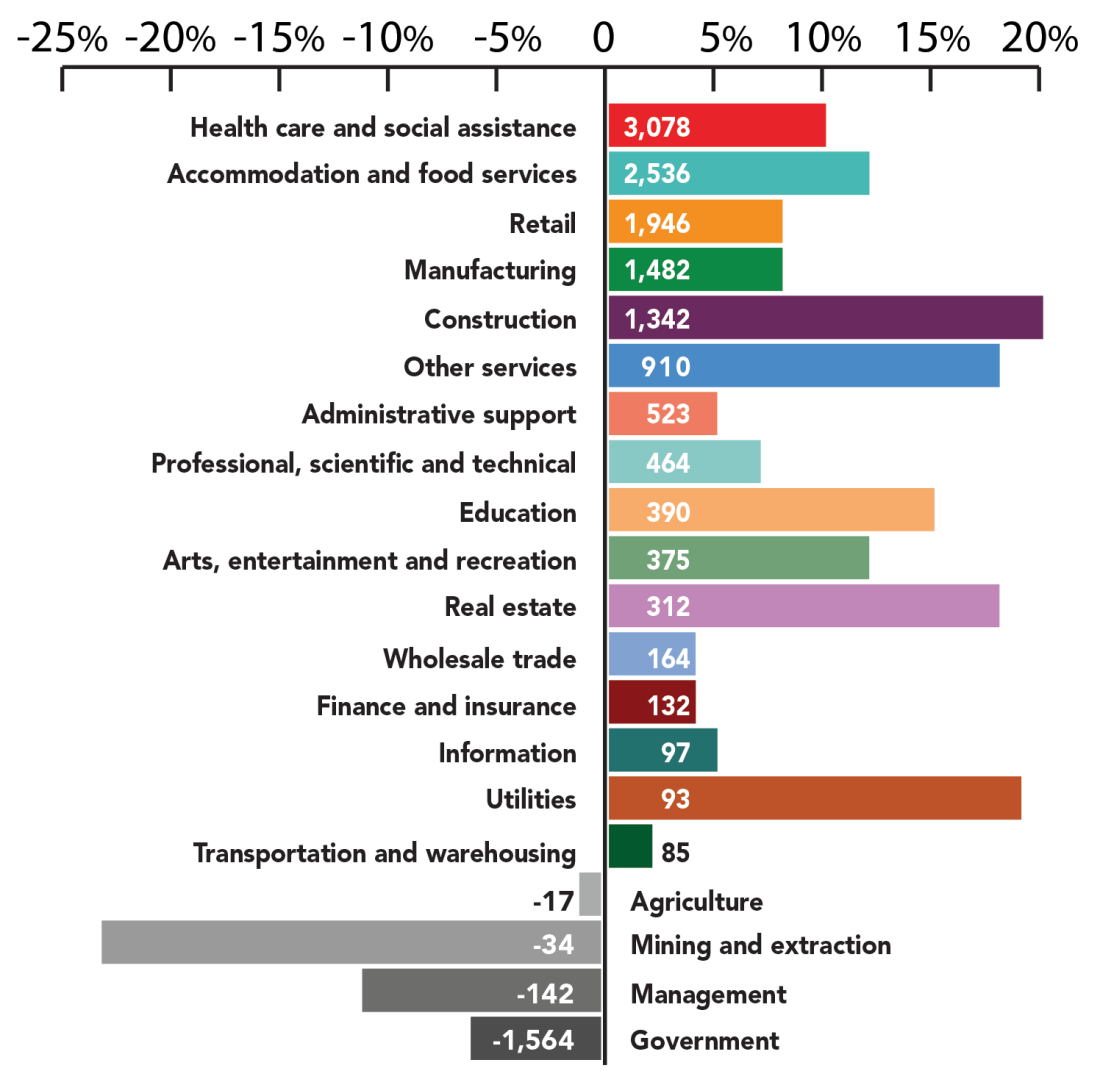Asheville’s bustling economy owes much to the city’s continued popularity as a tourist destination, but the area is also benefiting from a wave of local business expansions.
Kit Cramer, president and CEO of the Asheville Area Chamber of Commerce, says the strongest trend she’s seeing is good, steady growth. “We’ve grown between 2 percent to 3 percent each year for the last three years. That is not a staggering level, but solid and manageable. There are business opportunities related to that level of growth.”
Sam Powers, the city’s director of community and economic development, cites job growth as a particularly encouraging sign. “Asheville’s economy continues to be well-balanced and seeing growth in employment in almost all job sectors. No sectors lost overall from last year to this year,” he reports.
According to the chamber’s research, the Asheville metropolitan statistical area, which includes Buncombe, Haywood, Henderson and Madison counties, saw a 7.1 percent increase in jobs over the last few years, from 171,705 in 2013 to 183,876 in 2016. Buncombe County alone had 8.7 percent job growth, from 116,447 in 2013 to 126,558 last year. That’s significantly higher than North Carolina’s 6.7 percent growth during the same period.
Tourism going strong
Tourism, which has historically been a major economic driver for the region, continues to show strength. The sector, notes Powers, “has played a significant role in the overall Asheville metro economy for many years. There’s no reason to expect the trend will not continue.”
What might change as tastes and trends evolve, he continues, is the kind of tourists Asheville attracts. “Almost everyone has seen the visible impact of the craft beverage industry and the significant … tourism spinoff created from that segment of manufacturing,” says Powers.
Ecotourism, health- and wellness-related tourism, adventure tourism and the live music industry, he notes, are areas where he’s seeing local entrepreneurs creating new businesses, new jobs and capital investment. “Just as our metro base in manufacturing is diverse, the tourism and hospitality industry is diverse in Asheville, which speaks positively to Asheville’s business landscape.”

Cramer also points to the city’s increasing popularity as a year-round vacation destination. “The fact that Asheville no longer shuts down in the cold-weather months means that we’ve been able to grow tourism,” she says.
Numbers from the Asheville Convention & Visitors Bureau show a marked increase in lodging revenue, up 10.7 percent to $24,305,660 in March 2017 compared with $21,960,208 in the previous March. Year-to-date revenue was 15.3 percent higher than at the same point last year. Occupancy was down slightly in March, by 1.9 percent, but the average daily lodging rate was up 4.7 percent, from $120.43 in March of 2016 to $126.11 this year.
The number of airport passengers also bore out the trend. As of March, year-to-date air passenger traffic stood at 166,397, compared with 139,683 at the same point in 2016, a 19.1 percent increase.
Cramer believes those numbers still leave room for growth. “Without a doubt, there are still tourism growth opportunities midweek.” And tourism aside, she continues, “We’d like to see additional business-related travel.”
Diverse economy brings balance
While tourists continue to flock to Buncombe County, Cramer hopes that popularity will continue to spill over into other parts of the economy. “Asheville is a well-known tourism destination, and we hope to have more opportunities to recruit other kinds of businesses. Asheville’s brand is strong. We need to use it and be very intentional about how we grow other sectors,” she believes.
“There is strength in balance. It makes a community more recession-resistant. An economy includes all kinds of businesses, so we need tourism to remain vibrant, just as we do manufacturing and health care and professional services. They all rely upon one another,” she points out.
Chamber research found that between 2012 and 2015, the three sectors that added the most businesses were professional, scientific and technical services (92); real estate, rental and leasing (90); and retail trade (81).
“Health care, hospitality, restaurants and construction have all had strong growth. We can literally see it happening. Mission Health is currently undergoing a massive construction project. We’ve also got both building and transportation construction projects around the county,” notes Cramer.
As of April, the metro area’s top employment sectors were health services and private education, with 37,400 jobs, leisure and hospitality, with 28,100 jobs, and government and retail trade, each with 26,000 jobs.
Local businesses branching out
Despite the many highly visible construction projects by big companies such as hotel chains, says Cramer, many of the area’s restaurants, retail, arts and tourism-related businesses are still small and locally owned.
When Asheville businesses have entered into partnerships or mergers with larger companies, she says, the result has often been a stronger contributor to the local economy.
“In most cases, an infusion of cash can help an existing company grow and do more of what they currently do. Generally, an acquisition is made because of the strength of the business’s concept and the work that has already been done.” Smart investors, Cramer maintains, “build on what has already been accomplished.”

And many local businesses, says Powers, are finding ways to expand without being bought up by big national firms. “That speaks to the confidence that our local existing business community has in our economy,” he notes.
But that expansion needs to be sustainable, stresses Cramer. “Our economic developers work with entrepreneurs that are interested in scaling up their companies. They also work with existing businesses on retention and expansion. And we also work with prospects that will bring new companies to town,” she points out.
According to Cramer, the city has been largely successful at retaining existing jobs. Since 2010, she notes, 77 percent of the Economic Development Coalition’s job announcements have come from expansion projects.
Many industries have shown healthy job growth since 2013, led by construction (20 percent increase) and utilities (19 percent). Real estate and other services have both seen 18 percent growth. Educational services, arts, entertainment, recreation, accommodation and food services also added significant numbers of jobs between 2013 and 2016.
Sectors losing jobs during that period include crop and animal production; mining, quarrying, and oil and gas extraction; management of companies and enterprises; and government.
Meanwhile, Asheville continues to position itself as a desirable destination for companies looking to relocate. “There is certainly interest in Asheville both as a location for businesses and as a place to live for talented people,” says Cramer. “Our staff keeps track of our prospect pipeline, which shows the various stages of interest from clients.”
The Economic Development Coalition’s current project pipeline shows 38 businesses representing 3,382 potential new jobs and $495 million in capital investment in the following sectors: manufacturing, medical products, professional and technical services, alternative energy, natural products and food manufacturing, and call centers.
Those companies, says Cramer, have the same concerns as existing businesses: capital, appropriate talent and connections to other people with whom they can do business.
Tight job market creates challenges
The biggest concern among longtime local business owners is the effect of lower unemployment rates, Cramer maintains. “They need workers with the right skills and the right attitude. They have to up their game in order to keep their existing workers and attract people for new positions,” she says, adding that salary, benefits and working conditions are all factors in landing top candidates.
For more than two years, the Asheville metro has had the lowest unemployment rate among the state’s metro areas. As of April, the area’s unemployment rate was 3.3 percent — the lowest April figure since 2000. In the city of Asheville, the unemployment rate sank to 3.2 percent in April. North Carolina had 4.3 percent unemployment that month, and the national rate was 4.1 percent.
But while that’s good news for workers and the overall economy, says Cramer, “Low unemployment puts pressure on wages and benefits. Business owners have to get competitive in order to attract and retain talent.”
But that challenge isn’t limited to Asheville, notes Powers. Across North Carolina, “Almost all of the major metropolitan areas are experiencing low unemployment rates. Employers must work with workforce development agencies to find innovative solutions to engaging and retaining employees.”






As are the taxes put on residential owners to pay for it.
Filing period for the election begins July 7.
I’ll kick in $20 LOL.
Awesome!